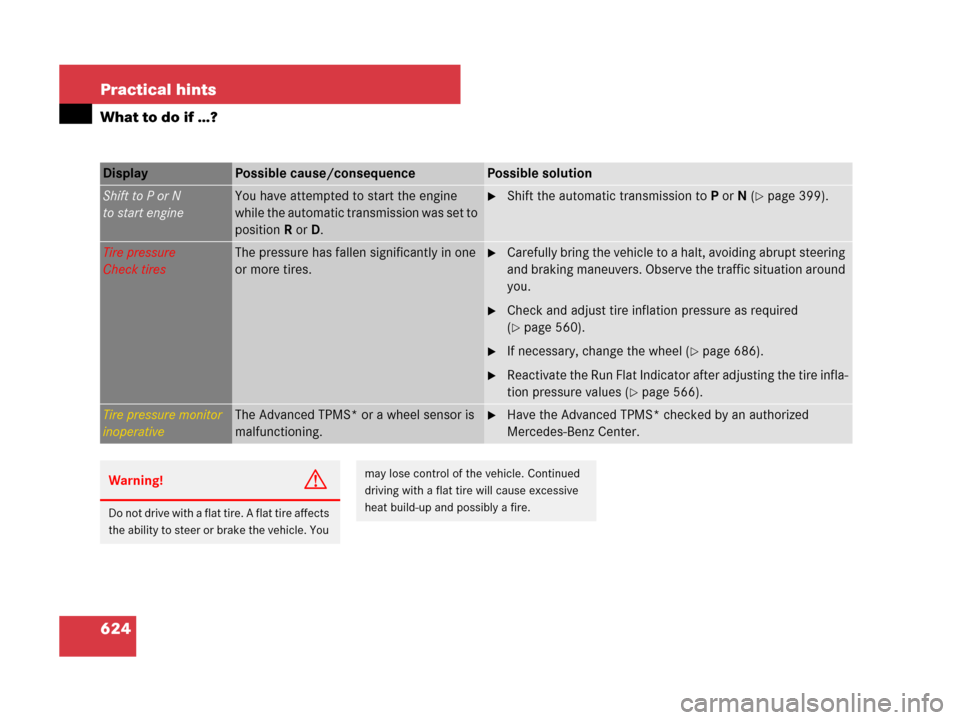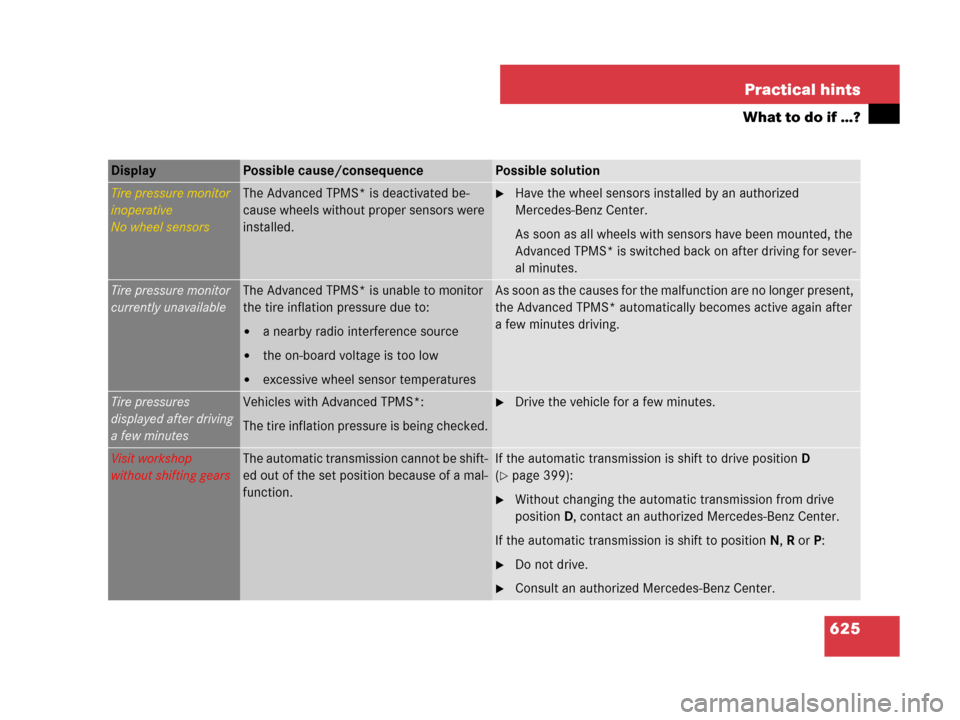Page 596 of 761

595 Operation
Vehicle care
Upholstery
Using aftermarket seat covers or wearing
clothing that have the tendency to give off
coloring (e.g. when wet, etc.) may cause
the upholstery to become permanently dis-
colored. By lining the seats with a proper
intermediate cover, contact-discoloration
will be prevented.Leather upholstery
�Wipe leather upholstery with a damp
cloth and dry thoroughly or clean with
Mercedes-Benz approved Leather
Care.
Exercise particular care when cleaning per-
forated leather as its underside should not
become wet.
Wood trims
�Dampen cloth using water and use
damp cloth to clean wood trims in your
vehicle.
Warning!G
Only use seat or head restraint covers which
have been tested and approved by
Mercedes-Benz for your vehicle model.
Using other seat or head restraint covers
may interfere with or prevent the activation
of the active head restraints.
Contact an authorized Mercedes-Benz Cen-
ter for availability.
!Do not use solvents like tar remover or
wheel cleaner nor polishes or waxes as these
may be abrasive.
Page 599 of 761

598 Practical hints
What to do if …?
Lamps in instrument cluster
General information:
If any of the following lamps in the instru-
ment cluster fails to come on during the
bulb self-check when switching on the igni-
tion, have the respective bulb checked and
replaced if necessary.
ProblemPossible cause/consequenceSuggested solution
-The yellow Antilock
Brake System (ABS)
indicator lamp comes on
while the engine is run-
ning.The ABS has detected a malfunction and
has switched off. The BAS, ESP®, EBP and
PRE-SAFE® are also switched off (see mes-
sages in multifunction display).
The brake system is still functioning nor-
mally but without the ABS available.
If the ABS control unit is malfunctioning,
other systems such as Parktronic*,
DISTRONIC Plus*, navigation system, Park
Assist* and the automatic transmission
may also be malfunctioning.
�Continue driving with added caution.
Wheels may lock during hard braking,
reducing steering capability.
�Read and observe messages in the mul-
tifunction display (
�page 612).
�Have the system checked at an autho-
rized Mercedes-Benz Center as soon as
possible.
Failure to follow these instructions increas-
es the risk of an accident.
Page 600 of 761

599 Practical hints
What to do if …?
ProblemPossible cause/consequenceSuggested solution
-The yellow Antilock
Brake System (ABS)
indicator lamp comes on
while the engine is run-
ning.The charging voltage has fallen below
10 volts. The ABS has switched off.
The battery may not be charged sufficiently.When the voltage is above this value again,
the ABS is operational again and the ABS in-
dicator lamp should go out.
If the ABS indicator lamp does not go out:
�Have the generator (alternator) and the
battery checked.
When the voltage is above this value again,
the ABS is operational again.
;
(USA only)
3
(Canada only)
-
v
The red brake warning
lamp comes on while the
engine is running. In addi-
tion, the yellow ABS mal-
function indicator lamp,
and the yellow ESP
®
warning lamp come on
and an acoustic warning
sounds.
A malfunction in the Electronic Brake Pro-
portioning (EBP) was detected. The ABS,
BAS, ESP
® and PRE-SAFE® are also
switched off (see messages in multifunction
display).
The brake system continues to function
normally, but without electronic support.
�Continue driving with added caution.
Wheels may lock during hard braking,
reducing steering capability.
�Read and observe messages in the mul-
tifunction display (
�page 612).
�Have the system checked at an autho-
rized Mercedes-Benz Center as soon as
possible.
Failure to follow these instructions increas-
es the risk of an accident.
Page 601 of 761

600 Practical hints
What to do if …?
ProblemPossible cause/consequenceSuggested solution
-
vThe yellow ABS malfunc-
tion indicator lamp and
the yellow ESP
® warning
lamp come on while the
engine is running and an
acoustic warning sounds.
ABS and ESP® are switched off due to a
malfunction.
The BAS, EBP and PRE-SAFE
® are also
switched off.
The brake system is still functioning nor-
mally but without the ABS available.
�Continue driving with added caution.
Wheels may lock during hard braking,
reducing steering capability.
�Read and observe messages in the mul-
tifunction display (
�page 612).
�Have the system checked at an autho-
rized Mercedes-Benz Center as soon as
possible.
Failure to follow these instructions increas-
es the risk of an accident.
0
(USA only)
!
(Canada only)
The red indicator lamp
for the electronic parking
brake flashes and/or the
yellow warning lamp for
the electronic parking
brake is on.The electronic parking brake is malfunction-
ing or defective.�Read and observe messages in the mul-
tifunction display (
�page 612).
�Have the system checked at an autho-
rized Mercedes-Benz Center as soon as
possible.
Page 610 of 761

609 Practical hints
What to do if …?
Warning!G
Each tire, including the spare (if provided),
should be checked monthly when cold and
inflated to the inflation pressure recom-
mended by the vehicle manufacturer on the
vehicle placard or the tire inflation pressure
label. (If your vehicle has tires of a different
size than the size indicated on the vehicle
placard or the tire inflation pressure label,
you should determine the proper tire infla-
tion pressure for those tires).
As an added safety feature, your vehicle has
been equipped with a tire pressure monitor-
ing system (TPMS) that illuminates a low tire
pressure telltale when one or more of your
tires is significantly under-inflated. Accord-
ingly, when the low tire pressure telltale illu-
minates, you should stop and check your
tires as soon as possible, and inflate them to
the proper pressure. Driving on a significant-
ly under-inflated tire causes the tire to over-
heat and can lead to tire failure.
Under-inflation also reduces fuel efficiency
and tire tread life, and may affect the vehi-
cle’s handling and stopping ability. Please
note that the TPMS is not a substitute for
proper tire maintenance, and it is the driv-
er’s responsibility to maintain correct tire
pressure, even if under-inflation has not
reached the level to trigger illumination of
the TPMS low tire pressure telltale.
USA only:
Your vehicle has also been equipped with a
TPMS malfunction indicator to indicate
when the system is not operating properly.
The TPMS malfunction indicator is com-
bined with the low tire pressure telltale.
When the system detects a malfunction, the
telltale will flash for approximately
one minute and then remain continuously
illuminated. This sequence will continue
upon subsequent vehicle start-ups as long
as the malfunction exists. When the mal-
function indicator is illuminated, the system
may not be able to detect or signal low tire
pressure as intended.TPMS malfunctions may occur for a variety
of reasons, including the installation of
replacement or alternate tires or wheels on
the vehicle that prevent the TPMS from
functioning properly. Always check the
TPMS malfunction telltale after replacing
one or more tires or wheels on your vehicle
to ensure that the replacement or alternate
tires and wheels allow the TPMS to continue
to function properly.
Page 613 of 761

612 Practical hints
What to do if …?
Vehicle status messages in the multi-
function display
Warning and malfunction messages ap-
pear in the multifunction display located in
the instrument cluster.
Certain warning and malfunction messag-
es are accompanied by an audible signal.
High-priority messages are shown in red
on the multifunction display. Messages of
lower priority are also shown in yellow or
white.
Address these messages accordingly and
follow the additional instructions given in
this Operator’s Manual.Certain messages of high priority cannot
be cleared from the multifunction display
using# or L on the multifunction
steering wheel (
�page 265).
Other messages of high priority and mes-
sages of less immediate priority can be
cleared from the multifunction display
using# or L. They are then stored
in the vehicle status message memory
(
�page 280). Remember that clearing a
message will only make the message dis-
appear. Clearing a message will not cor-
rect the condition that caused the
message to appear.
Warning!G
No messages will be displayed if either the
instrument cluster or the multifunction dis-
play is inoperative.
As a result, you will not be able to see infor-
mation about your driving conditions, such
as speed or outside temperature, warn-
ing/indicator lamps, malfunction/warning
messages or the failure of any systems.
Driving characteristics may be impaired.
If you must continue to drive, please do so
with added caution. Contact an authorized
Mercedes-Benz Center as soon as possible.
Page 625 of 761

624 Practical hints
What to do if …?
Display Possible cause/consequencePossible solution
Shift to P or N
to start engineYou have attempted to start the engine
while the automatic transmission was set to
position R or D.�Shift the automatic transmission to P or N (�page 399).
Tire pressure
Check tiresThe pressure has fallen significantly in one
or more tires.�Carefully bring the vehicle to a halt, avoiding abrupt steering
and braking maneuvers. Observe the traffic situation around
you.
�Check and adjust tire inflation pressure as required
(
�page 560).
�If necessary, change the wheel (�page 686).
�Reactivate the Run Flat Indicator after adjusting the tire infla-
tion pressure values (
�page 566).
Tire pressure monitor
inoperativeThe Advanced TPMS* or a wheel sensor is
malfunctioning.�Have the Advanced TPMS* checked by an authorized
Mercedes-Benz Center.
Warning!G
Do not drive with a flat tire. A flat tire affects
the ability to steer or brake the vehicle. You
may lose control of the vehicle. Continued
driving with a flat tire will cause excessive
heat build-up and possibly a fire.
Page 626 of 761

625 Practical hints
What to do if …?
Display Possible cause/consequencePossible solution
Tire pressure monitor
inoperative
No wheel sensorsThe Advanced TPMS* is deactivated be-
cause wheels without proper sensors were
installed.�Have the wheel sensors installed by an authorized
Mercedes-Benz Center.
As soon as all wheels with sensors have been mounted, the
Advanced TPMS* is switched back on after driving for sever-
al minutes.
Tire pressure monitor
currently unavailableThe Advanced TPMS* is unable to monitor
the tire inflation pressure due to:
�a nearby radio interference source
�the on-board voltage is too low
�excessive wheel sensor temperatures
As soon as the causes for the malfunction are no longer present,
the Advanced TPMS* automatically becomes active again after
a few minutes driving.
Tire pressures
displayed after driving
a few minutesVehicles with Advanced TPMS*:
The tire inflation pressure is being checked.�Drive the vehicle for a few minutes.
Visit workshop
without shifting gearsThe automatic transmission cannot be shift-
ed out of the set position because of a mal-
function.If the automatic transmission is shift to drive positionD
(
�page 399):
�Without changing the automatic transmission from drive
positionD, contact an authorized Mercedes-Benz Center.
If the automatic transmission is shift to positionN, R or P:
�Do not drive.
�Consult an authorized Mercedes-Benz Center.